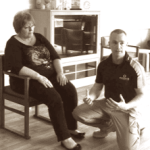“I thoroughly enjoyed the course. I had previously attended the Team Teach course a number of years ago and found it really intense and did not feel confident in using it. I feel very confident now that as a last resort I can protect myself and the children I am responsible for. I found the legal information very interesting and appropriate.”
This comment was provided just last week by the Development Officer for a regional autism support organisation in the South-East. Our team had been called in to help this organisation with understanding positive handling with children, for example:
- when children were being disruptive in group sessions
- during group excursions when children would refuse to get on a bus
- managing location transitions or task-avoidance
Our Director of Training, Gerard O’Dea, led the group through a blended programme of personal safety strategies for managing proximity and body language signals, including adapted verbal communications tactics for children with autism in the various scenarios which came up. The group also wanted to learn about prompting and guiding tactics in addition to the more robust holding and immobilisations needed in more serious circumstances to prevent harm.
MESHING SKILLS
A key principle of our current training methodology, which is always evolving, is that physical skills and non-verbal and verbal communications must be blended together (or as our special adviser Gary Klugiewicz from ‘Verbal Defense and Influence‘ describes it: “meshed“) so that the psychomotor skills of conflict communications as well as those of personal safety and physical interventions are all practiced together – in the same way that they will be required during an incident.
The group was particularly interested in the Persuasion Sequence and its underlying principles, and how the consistency of such a carefully crafted communication can do a number of key things:
- Make sure that the contact professional Looks Good and Sounds Good, so everything Is Good.
- Ensures, in a structured way, that the child is treated with dignity and is shown respect, even in their worst moments
- Helps to ensure that there is a relationship which can be repaired and strengthened after an incident, because of the inherent fairness and autonomy which is built into the professional’s communication style.
- Gain voluntary compliance, cooperation and collaboration more often with more certainty
- Help with the inevitable investigation or proceedings when a physical intervention is used with a child.
These are all principles and concepts which are driven by our ‘Verbal Defense and Influence‘ programme which, in partnership with Vistelar we are rolling out to our clients in an effort to help them to create safe and secure services.
Further feedback from the same course:
“The course gave me a lot of the confidence I need to support my work with children and adults with special needs. The practical work that we done was in a safe environment, also the instructor was helpful by walking round and giving advice that supported the way we held and restrained. Also by giving us tips on how to practise in a more safe way for example when tying up shoelaces/ talking to the child.”
—————————————
Gerard O’Dea is a conflict management, personal safety and physical interventions training consultant. He is the training director for Dynamis, a specialist provider of personal safety and violence management programmes and the European Adviser for ‘Verbal Defense and Influence’, a global programme which addresses the spectrum of human conflict. www.dynamis.training




